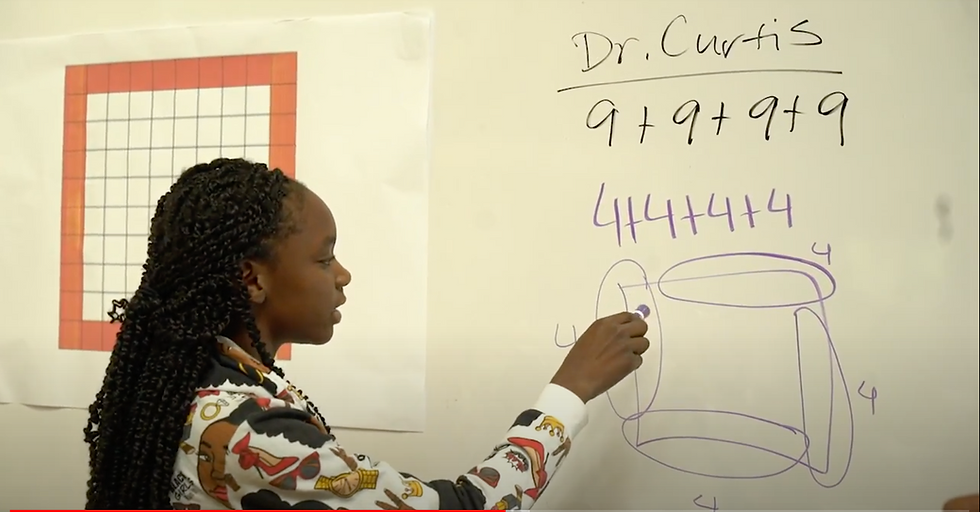MAIC Discourse the Main Course Pt.3
- Yay Math!
- Jan 31, 2019
- 4 min read
Updated: Feb 14, 2019
To celebrate the New Year let’s continue with our little soiree. We were exploring how to create rich mathematics discussions in our classrooms – the main course of a student-centered lesson. In a robust math discussion, the students are focused on making sense of the big mathematical ideas being explored in the lesson. In mathematical discussions, students share ideas, listen and make sense of other students’ thinking, and debate the merits of different ideas. However, making this type of discussion a reality can be challenging.
Math education professors Elham Kazemi and Allison Hintz and authors of Intentional Talk: How to Structure and Lead Productive Mathematical Discussions” summarize what many of us have experienced when trying to facilitate a class discussion.
“Leading mathematical discussions can be both invigorating and challenging. It’s easy to start a discussion by asking children to share their thinking. And nothing beats those moments when children proudly share something they figured out. But then what? Math discussions aren’t just about show-and-tell: stand up, sit down, clap, clap, clap. Knowing what to do with students’ ideas and teaching children how to meaningfully participate in discussions can be a lot more daunting. We often worry during a discussion that students might get lost trying to keep up with what everyone is saying or that they may simply tune out when a lot of ideas are shared. And no teacher likes that uncomfortable feeling of putting a child on the spot. Yet when teachers plan for and steer productive discussions, children realize it’s worth listening to one another and that it’s okay to be pressed to say more”
Many of us have shared similar struggles when trying to facilitate classroom discussions. So how do we stop our discussions from becoming "show and tell"?
The authors outline six different types of classroom discussions each with a different focus. From “Open Strategy Sharing” to “Why? Let’s Justify” In this video the authors outline a few others and how they differ. Here is a quick overview:

Planning for different types of discussion is certainly helpful but also having facilitation strategies to use while the discussions occur is also key. Below are a few strategies for slowing down a discussion to focus on the underlying mathematics & students’ thinking.
Ask a student to explain/restate or build on another student’s contribution.
Use questions that encourage connection building such as “What is the same about these strategies and what is different?”
Ask the class to try the presented strategy, but with different numbers. If they get they stuck ask them to write down questions for the presenter.
Ask students to write down three questions they have about what another student shared and then call on 3 random students. Sentence starters can help all students in formulating questions.
Use the double huddle to provide the presenting group time to discuss a new idea or question before responding to the class; while the presenting group huddles, you pose a question for the rest of the class to discuss with an elbow partner or table group. Common questions could be “How would you respond to this question?” “What would you need to be convinced of this?
When a student starts to share a lot of information all at once (like how they found an answer), pause them quickly and ask the class what questions or comments they have related to just the first ‘step’ or claim shared by the student. If no one raises their hand (a common issue ) then say “Great! I have lots of questions but I will ask the audience."
Prior to student(s) presenting, give them a heads up and specific instructions about what you want them to present, "Jasmin, I really like how you organized the information in this table. I would love for you to share this method with the class. Please draw it out on the board and be ready to tell us how you found the numbers in the table"
You’ve probably noticed that here at MAIC we LOVE a good theme and the last few newsletters we've cooked up are centered around one main idea: the importance of intention.
Intentionally teaching students how to converse with each other. Intentionally
sparking conversations with bite sized morsels of mathematical goodness and intentionally planning for student presentations. Whatever your intention may be for 2019, we hope you will raise a glass to making your students’ thinking the centerpiece of your classroom this year.
Cheers!
Bright Spots
As we come back from break many classrooms are revisiting and resetting classroom culture especially around group work. The practice of group work is highly impactful and one of the most challenging to implement as it takes constant and intentional modeling and teaching.
Leandra (8th grade teacher) shared the following videos of her and her colleagues doing group work with her class and had them discuss what these groups did well and where they could improve. The students LOVED watching their teachers and giving feedback.
Leandra then had students develop personalized goals around group work and provided them with an accountability tool.

Curtis (6th grade teacher) had students consider what each group norm would “sound” and “look like” using a "Give One, Get One, Move on" protocol. Each student records their ideas and then passes their paper around the table to get ideas from their peers.

Curtis then recorded each table's ideas for the class to consider and then had the class vote to come to a consensus.

MAIC-ing It Happen!
We are excited to announce our second Public Lesson Study. The event will take place on March 5 at the GSE forum! Katie Pond Waters and the rest of the research team is currently working hard on preparing for this upcoming event! We hope to see many of you there.
Yay Math!



Comments